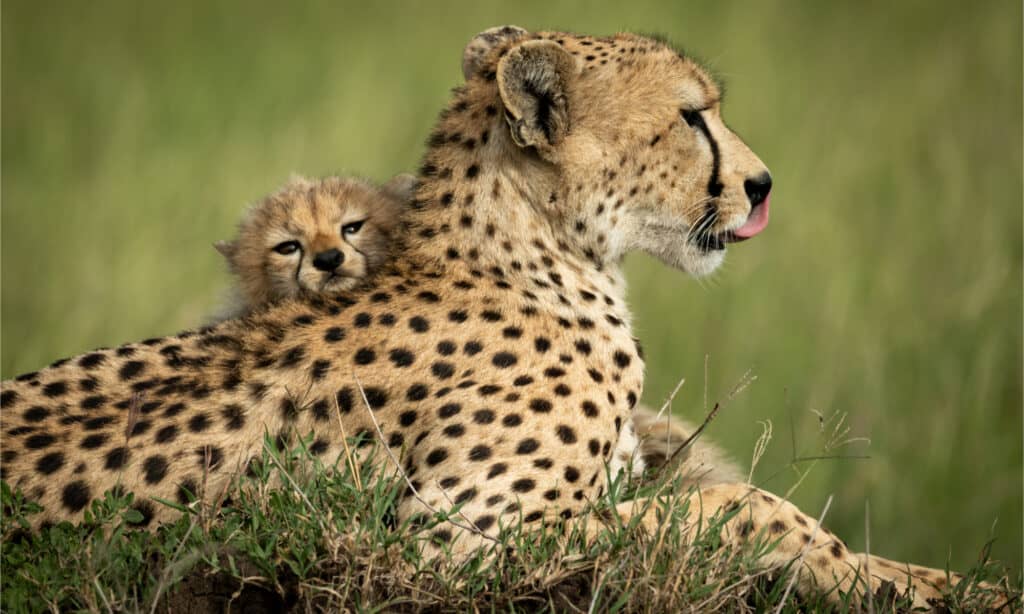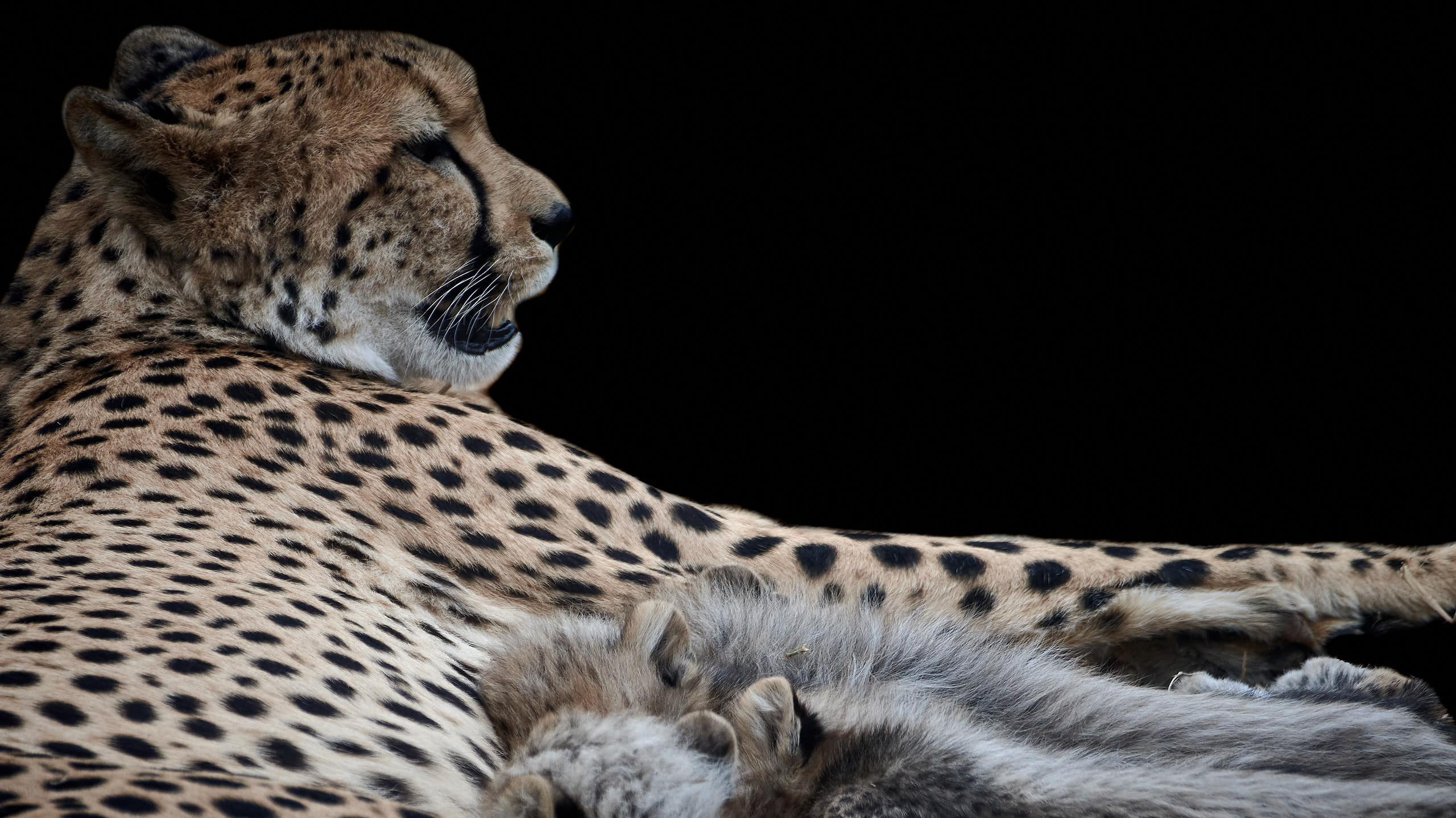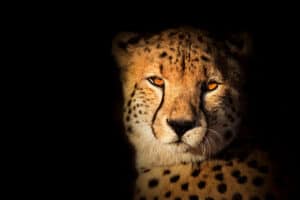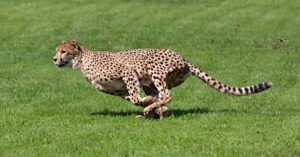September 12, 2023, marked a momentous occasion for cheetah lovers and conservationists worldwide! The Smithsonian’s National Zoo & Conservation Biology Institute (NZCBI) celebrated a most exciting cheetah cub birth to their female cheetah, Echo.
NZCBI confirmed Echo’s second pregnancy on July 28, 2023, via ultrasound. From there, the waiting game began. Cheetah pregnancies last about three months. Unfortunately, the sixth cheetah cub passed away shortly after birth. However, the remaining five cubs appear healthy and strong. They are nursing well and starting to open their eyes. Soon, they’ll be ready to begin exploring their den.
Keepers confirmed during a brief examination of the cubs two females and three males. The cubs will eventually become vital members of the Cheetah Species Survival Plan (Cheetah SSP). Hopefully, that entails more cheetah cub births in the future!
NZCBI even set up a Cheetah Cub Cam where viewers can watch the incredible litter as they grow. Let’s learn more about cheetah cubs and the weight of their species’ survival they carry on their tiny shoulders. Then, watch the video of the adorable cheetah cubs with their mother at the end!

Cheetah cubs stay with their mother from birth until about 18 months old.
©Stu Porter/Shutterstock.com
Why Are These Cheetah Cubs So Important?
Cheetahs are an endangered species. Between 1980 and today, the wild cheetah population has dwindled from greater than 25,000 individuals to just 7,000. That means only 28% of wild cheetahs still exist in this world. Cheetahs used to roam most of Africa, India, and some parts of Asia. Now, they roam free only in Africa and a small part of Iran. The International Union for Conservation of Nature and Natural Resources (IUCN) lists them as critically endangered as of 2023.
This population devastation is the result of many factors. Over the last few decades, habitat loss and poaching stood out as key problems for cheetahs. Poachers kill cheetahs to sell their beautiful coats and even their meat. Just like other predators, human-animal conflict plays a huge part in their decline, as well. Not to mention, cheetah cubs also live a tough life from birth. A pitiful 5% of them survive to adulthood in the wild. They are targeted by lions, leopards, and hyenas that aim to reduce competition for resources. A cheetah cub’s mother does not possess the strength to fend off predators so much larger and stronger than herself. They die in accidents related to learning how to hunt. Cheetah cubs also find themselves stolen from their mothers and entered into the illegal pet trade. If the babies can not keep up or become injured, their mother must leave them behind. Without their mother, they will starve or be killed by other predators.
All of these incidents together contribute to the decimation of the wild cheetah population. Each cheetah cub born in captivity gives hope to the species. They each become an integral part of breeding programs aimed at restoring wild populations and preserving the species for years to come. Without these programs, cheetahs would become extinct. They have been on the verge of extinction several times in the last few decades. Despite these terrible odds, conservationists around the world still strive to save them.

Cheetah cubs face many dangers from the moment they’re born.
©nwdph/Shutterstock.com
How Will These Cheetah Cubs Contribute to Cheetah Population?
The Cheetah SSP was created by the Association of Zoos and Aquariums (AZA) in 2014. Cheetah SSP partnered with The Cheetah Sustainability Program (CSP) in North America to create a stable and viable population of healthy, breeding cheetahs. Together, these organizations, along with 10 cheetah breeding centers, create the Cheetah Breeding Center Coalition. Every cheetah born into one of these facilities will go on to become a breeding adult at another facility. NZCBI, like the other nine breeding centers, houses many cheetahs and keeps close track of breeding, births, and pedigrees of the big cats. This record-keeping ensures the ability to maintain a healthy and diverse gene pool. NZCBI alone houses 30 cheetahs and celebrates a litter count of 81 with this recent cheetah cub birth!
You Can Help!
If you want to help cheetahs survive, consider contributing to a national or international cheetah conservation organization such as the Cheetah Conservation Fund. Talk to your friends, and visit the zoos that make up the Coalition! You can find the list of all zoos and organizations that support the program at our CSP link above. Other organizations include Running Wild Cheetah Conservation. RWC breeds cheetahs, then raises and re-wilds them to be released within Africa to improve populations there!
Watch the Adorable Video of the Cheetah Cubs Born at the Smithsonian Zoo Below!
Thank you for reading! Have some feedback for us? Contact the AZ Animals editorial team.








